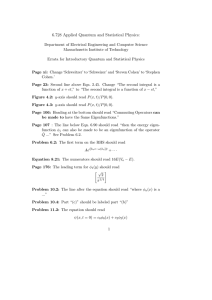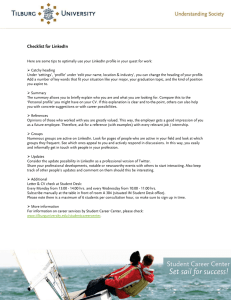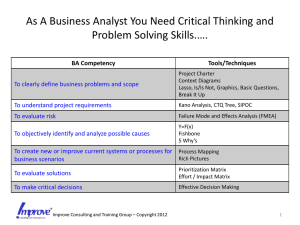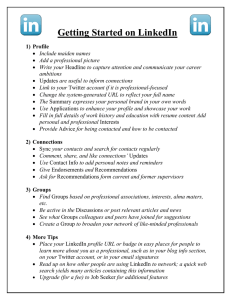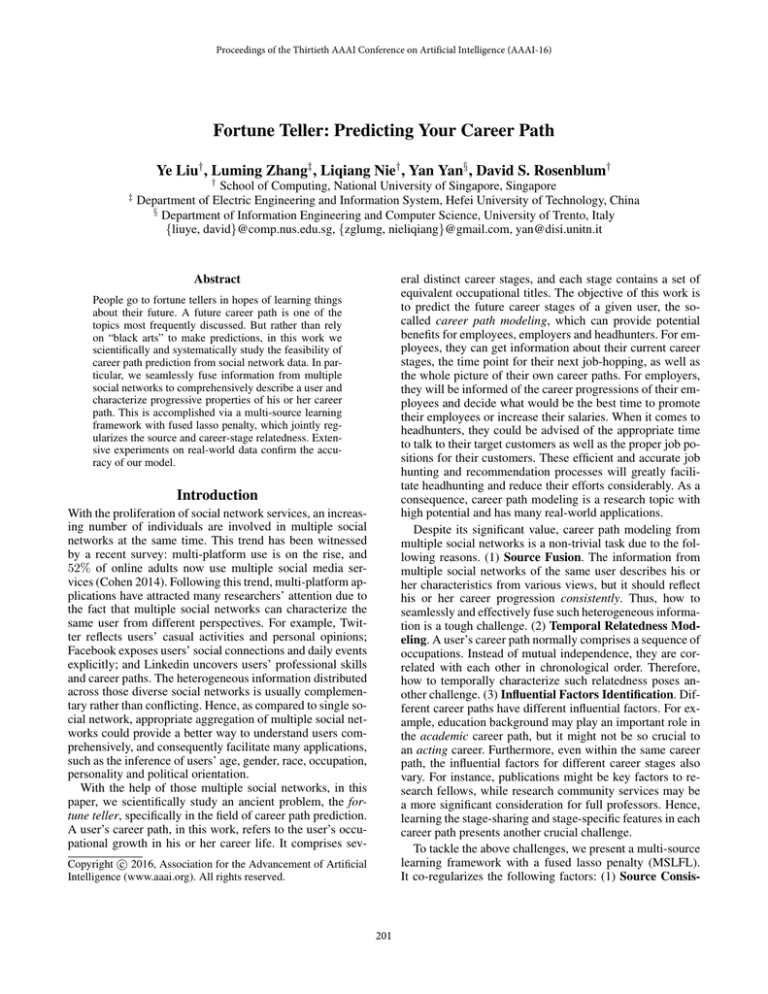
Proceedings of the Thirtieth AAAI Conference on Artificial Intelligence (AAAI-16)
Fortune Teller: Predicting Your Career Path
Ye Liu† , Luming Zhang‡ , Liqiang Nie† , Yan Yan§ , David S. Rosenblum†
†
‡
School of Computing, National University of Singapore, Singapore
Department of Electric Engineering and Information System, Hefei University of Technology, China
§
Department of Information Engineering and Computer Science, University of Trento, Italy
{liuye, david}@comp.nus.edu.sg, {zglumg, nieliqiang}@gmail.com, yan@disi.unitn.it
eral distinct career stages, and each stage contains a set of
equivalent occupational titles. The objective of this work is
to predict the future career stages of a given user, the socalled career path modeling, which can provide potential
benefits for employees, employers and headhunters. For employees, they can get information about their current career
stages, the time point for their next job-hopping, as well as
the whole picture of their own career paths. For employers,
they will be informed of the career progressions of their employees and decide what would be the best time to promote
their employees or increase their salaries. When it comes to
headhunters, they could be advised of the appropriate time
to talk to their target customers as well as the proper job positions for their customers. These efficient and accurate job
hunting and recommendation processes will greatly facilitate headhunting and reduce their efforts considerably. As a
consequence, career path modeling is a research topic with
high potential and has many real-world applications.
Despite its significant value, career path modeling from
multiple social networks is a non-trivial task due to the following reasons. (1) Source Fusion. The information from
multiple social networks of the same user describes his or
her characteristics from various views, but it should reflect
his or her career progression consistently. Thus, how to
seamlessly and effectively fuse such heterogeneous information is a tough challenge. (2) Temporal Relatedness Modeling. A user’s career path normally comprises a sequence of
occupations. Instead of mutual independence, they are correlated with each other in chronological order. Therefore,
how to temporally characterize such relatedness poses another challenge. (3) Influential Factors Identification. Different career paths have different influential factors. For example, education background may play an important role in
the academic career path, but it might not be so crucial to
an acting career. Furthermore, even within the same career
path, the influential factors for different career stages also
vary. For instance, publications might be key factors to research fellows, while research community services may be
a more significant consideration for full professors. Hence,
learning the stage-sharing and stage-specific features in each
career path presents another crucial challenge.
To tackle the above challenges, we present a multi-source
learning framework with a fused lasso penalty (MSLFL).
It co-regularizes the following factors: (1) Source Consis-
Abstract
People go to fortune tellers in hopes of learning things
about their future. A future career path is one of the
topics most frequently discussed. But rather than rely
on “black arts” to make predictions, in this work we
scientifically and systematically study the feasibility of
career path prediction from social network data. In particular, we seamlessly fuse information from multiple
social networks to comprehensively describe a user and
characterize progressive properties of his or her career
path. This is accomplished via a multi-source learning
framework with fused lasso penalty, which jointly regularizes the source and career-stage relatedness. Extensive experiments on real-world data confirm the accuracy of our model.
Introduction
With the proliferation of social network services, an increasing number of individuals are involved in multiple social
networks at the same time. This trend has been witnessed
by a recent survey: multi-platform use is on the rise, and
52% of online adults now use multiple social media services (Cohen 2014). Following this trend, multi-platform applications have attracted many researchers’ attention due to
the fact that multiple social networks can characterize the
same user from different perspectives. For example, Twitter reflects users’ casual activities and personal opinions;
Facebook exposes users’ social connections and daily events
explicitly; and Linkedin uncovers users’ professional skills
and career paths. The heterogeneous information distributed
across those diverse social networks is usually complementary rather than conflicting. Hence, as compared to single social network, appropriate aggregation of multiple social networks could provide a better way to understand users comprehensively, and consequently facilitate many applications,
such as the inference of users’ age, gender, race, occupation,
personality and political orientation.
With the help of those multiple social networks, in this
paper, we scientifically study an ancient problem, the fortune teller, specifically in the field of career path prediction.
A user’s career path, in this work, refers to the user’s occupational growth in his or her career life. It comprises sevc 2016, Association for the Advancement of Artificial
Copyright Intelligence (www.aaai.org). All rights reserved.
201
tency. In particular, the predicted results from individual
sources should be the same or similar. Thus their disagreements should be penalized. (2) Temporal Smoothness. The
career path is equally split into multiple time intervals, and
each of them is treated as a task. A career path is generally a gradual process, and hence sudden changes of career
stages between neighboring time points should be penalized.
For instance, it is much more smooth for a research fellow
to become an assistant professor rather than a full professor
in their next position. (3) Feature Learning. Features extracted from multiple sources are in high-dimension spaces.
We employ a fused lasso to control sparsity and identify the
task-sharing and task-specific features, which will identify
the influential factors that affect a user’s career progression
at different stages. This enhances the interpretation of influential factors.
We summarize the contributions as follows:
2012; Liu et al. 2015; Zheng and Ni 2013). In this framework, the prediction at each time point is treated as a task,
and the intrinsic correlations among different time points are
automatically learned, which could capture the dynamics effectively. For example, Zhou et al. (2011) proposed a multitask learning model to capture the intrinsic temporal relatedness for disease progression prediction. However, most exiting efforts on multi-task learning failed to consider the appropriate source fusion, which usually leads to suboptimal
performance.
Thus, multi-view multi-task learning is proposed to explore both source relatedness and task relatedness simultaneously (Zhang and Huan 2012; He and Lawrence 2011;
Jin et al. 2013). For instance, He et al. (2011) proposed a
graph-based iterative framework (GraM 2 ) for multi-view
multi-task learning and obtained impressive results in text
categorization applications. However, as far as we know,
the literature on multi-view multi-task learning is relatively
sparse, and very few efforts have been applied to career path
modeling. In contrast, our MSLFL model provides a natural way to fuse information from different sources by penalizing their disagreements. Moreover, MSLFL can better
capture the dynamic progressions of career paths and learn
the stage-sharing and stage-specific features via fused lasso
penalty.
• As far as we know, this is the first work on career path
modeling and prediction by exploring multiple social network sources. It can serve as a lifelong career mentor for
every professional.
• We present a novel multi-source learning framework with
fused lasso penalty to integrate multiple social network
sources and model a career path. In addition, this model
is able to identify the influential factors of career paths.
Data Collection and Preprocessing
Related Work
Social Accounts Alignment. To the best of our knowledge,
there is no available benchmark dataset suitable for career
path modeling. We thus created new datasets by crawling
four popular career paths, namely software engineer, sales,
consultant and marketing. Each career path is an individual
dataset. Social accounts assignment is the key challenge in
this data collection, which aims to build the links among
different social network accounts of the same user (Abel
et al. 2011; 2013; Meo et al. 2013). Towards this end, we
employed the social service About.me1 , which encourages
its users to list their multiple social accounts explicitly in
their personal profiles. We collected the data from About.me
by searching keywords corresponding to the career paths.
Considering the software engineer dataset as an example,
we used “software engineer”, “programmer” and “program
developer” as the keywords to search from About.me and
got 6, 284 candidates. Then we retained only those candidates who provided their Twitter (Tw), Facebook (Fb) and
Linkedin (Lk) accounts as the software engineer dataset.
The dataset statistics2 are presented in Table 1.
Career Stages and Occupation Variants. Based on prior
knowledge, we roughly split each career path in our collected datasets into four stages, where each stage represents
a milestone within the whole career path. Take software engineer as an example. We define it to compose four stages,
namely software developer, senior software developer, manager and CEO. It is worth noting that due to vocabulary vari-
It is worth mentioning that several research efforts have
been dedicated to occupation analysis from social networks (Preoţiuc-Pietro, Lampos, and Aletras 2015; Filatova and Prager 2012; Sloan et al. 2015). For example,
Preoţiuc-Pietro et al. (2015) inferred the occupation of a
user based upon user profiles and social contents. However,
they mainly used the information from one single source,
which makes it difficult to comprehensively characterize a
user’s personality from various aspects. Instead of learning from a single source, multi-source learning has been
proposed and has demonstrated its success in user modeling, profiling and behavior analysis with the assumption
that information extracted about the same user from different sources may complement one another (Abel et al. 2011;
2013; Meo et al. 2013; Xiang et al. 2013; Huang et al. 2014;
Song et al. 2015a; 2015b). For instance, Huang et al. (2014)
proposed a multi-source integration framework to infer a
user’s occupation by combining both content and network
information from Sina Weibo. However, as compared to occupation inference, career path modeling is much more complex, since it exhibits dual heterogeneities. In particular, besides comprehensive user description, a career path comprises a sequence of occupations and progressively develops
from junior to senior stages. Multi-source learning fails to
consider these progressions, and thus their performance is
far from satisfactory.
Multi-task learning is a learning paradigm that jointly
learns multiple related tasks and has demonstrated its advantages in handling dynamic progression problems in many
domains, such as medical science and transportation (Zhang
and Yeung 2010; Chang and Yang 2014; Zhou et al. 2011;
1
2
https://about.me/
The size of dataset depends on two factors: the total number of users returned
from about.me and the number of returned users with three accounts (Twitter, Facebook and Linkedin) available at the same time.
202
Table 1: Statistics of our collected benchmark dataset.
career path
Career Stages in Users’ Linkedin Profiles
࢛࢙ࢋ࢘
࢛࢙ࢋ࢘
Developer -- 1
Senior Developer -- 2
Manager -- 3
Manager -- 3
marketing
࢚
Manager -- 3
࢛࢙ࢋ࢘ࡺ
Senior Developer -- 2
Senior Developer -- 2
Manager -- 3
Founder -- 4
Career Path Modeling
Notation
We first define some notation. In particular, we use bold capital letters (e.g., X) and bold lowercase letters (e.g., x) to denote matrices and vectors, respectively. We employ non-bold
letters (e.g., x) to represent scalars, and Greek letters (e.g.,
λ) as parameters. Unless stated, otherwise, all vectors are in
column form.
Let us assume that we have N labeled users for a given
career path. This career path can be split into M time points
and each time point is aligned with a task. Meanwhile,
each user is described by S ≥ 2 sources. Xs ∈ RN ×Ds
denotes the feature matrix extracted from the s-th source,
where Ds is the feature dimension of the corresponding
source. The whole data matrix can be written
S as X =
{X1 , X2 , . . . , XS } ∈ RN ×D , where D =
s=1 Ds . The
label matrix is denoted as Y = {y1 , y2 , . . . , yM } ∈ RN ×M ,
T
N
and ym = (y1m , y2m , . . . , yN
is the label vector of
m) ∈ R
the m-th task.
Career stages
consultant
࢚
Senior Developer -- 2
Figure 1: Illustration of ground truth construction.
Table 2: Career stage partitions and term variants for the
same career stage.
sales
࢚
Developer -- 1
ations, different users utilize different occupational titles to
refer to the same career stage. For instance, in the marketing
career, product managers and marketing coordinators may
be used to refer to the same stage as marketing executive,
and we thus manually mapped all these semantically similar
occupations to the same career stage. Table 2 demonstrates
the career stage partition and occupational title variants for
the same career stage. Due to limited space, we are unable
to list all title variants.
software
engineer
࢚
Programmer -- 1
# of matching users
with Lk, Fb, Tw
2,478
1,412
3,567
4,884
software engineer
sales
consultant
marketing
# of users
crawled
6,284
4,359
13,067
8,974
software engineer/developer/programmer
senior software engineer/developer
principal/manager/leader/director
CEO/CTO/founder/owner
sales executive
senior sales executive/team lead/assistant manager
sales director/manager
founder/CEO/vice president/president
analyst/associate/consultant
senior associate/engagement manager/senior consultant
principal/senior manager/director
partner/founder/co-founder
marketing executive/product managers/marketing coordinators
senior marketing executive/marketing manager/brand manager
marketing director/CMO
founder/owner/CEO
Problem Formulation
The career status of users at the m-th time point can be linearly predicted from the s-the source as follows:
s
fm
(Xs ) = Xs wsm ,
wsm
(1)
Ds
where
∈ R denotes the linear mapping function for
the task m with source s. Without prior knowledge on the
contributions of different sources, we assume that all sources
contribute equally. Thus, the final prediction model of all
sources for task m is obtained by the following late fusion:
Ground Truth Construction. To simplify the computation, we quantized the four career stages in different career
paths from junior to senior as 1 to 4. For instance, software
developer, senior software developer, manager and CEO in
the software engineer path are mapped to 1, 2, 3 and 4, respectively. In addition, for each career path, we defined several time stamps with equivalent time period. In particular,
we chose the start time of a user’s first job as the first time
stamp. For example, for a given user u, his/her first work is
a software developer; we thus labeled his/her career stage
at time t0 as 1. Assuming that the gap between two neighboring time stamps in the software engineer path is three
years, then four years later the occupational title in his/her
Linkedin is senior software developer. We thus label his/her
career stages at time t1 as 2. On the other hand, from users’
Linkedin profiles, we can obtain their working experiences,
including occupational titles and corresponding time periods
(i.e., the career stage and time stamp). Figure 1 depicts the
ground truth construction for the career datasets.
fm (X) =
S
1 s
fm (Xs ).
S s=1
(2)
Information distributed in various sources in fact describes the inherent characteristics of the same user from
various views, and hence their predicted results should be
forced to be similar. In a sense, we can reinforce the learning
performance of individual sources. Considering the leastsquares loss function, we can define the following objective
function:
S
M
S
M
1 1 λ s 2
s
s 2
min
y −
Xs wm 2 +
Xs wm − Xs wm 2 .
wsm 2 m=1 m
S s=1
2 m=1 s,s =1
(3)
203
To consider the temporal smoothness of career progressions and learn descriptive features, we expand the model in
Eqn. (3) to incorporate a fused lasso penalty. This penalty
ensures a small deviation between two tasks at successive
time stamps and automatically selects task-specific and tasksharing features for career path modeling. In particular, the
fused lasso penalty comprises a temporal lasso and a regular lasso. Let W = {w1 , w2 , . . . , wM } ∈ RD×M denote the
overall weight matrix, where wm = {w1m , w2m , . . . , wSm }T ∈
RD . The overall objective function can be restated as
min
s
Wm
Then the overall objective function can be approximated
by
h(W)
g(W)
+
λ
2
S
W(k)
Optimization
∇h(W) =
The optimization of our overall objective function is not easy
due to the two non-smooth terms: temporal lasso and regular
lasso. To solve this problem, we first rewrite the second term
in Eqn. (4) as,
A∞≤1
A∞≤1
1
μ
max d(A) =
A∞ ≤1
1
1
A2F =
D(M − 1).
2μ
2μ
W(k) = max(0, 1 −
(13)
(14)
k
β
)B.
B1
(16)
We thus can solve Eqn.(12) quite efficiently.
(6)
Experiments
Experimental Settings
To validate our model, we first need to define the time
stamps. In particular, we treated the start time of a user’s
first job as the first time stamp (time t0 ), and set three years
as the time window between two neighboring time stamps,
since three years appears to be a typical period of time between transitions in a person’s career path. In this work, we
examined four successive time stamps for each user, since
we believe that nine years should be long enough to reflect a person’s career progressions effectively (Veiga 1981).
Meanwhile, each time stamp is aligned with a task. We kept
the same settings for all careers we considered. In addition,
we employed the average classification accuracy over these
four tasks in each career as our performance metric. The experimental results reported in this paper are based on 10-fold
cross-validation. The parameters were selected using grid
search on each career dataset.
(7)
(8)
where A is the optimal solution of Eqn. (6) and is computed
by
WH
),
μ
Pss = λ(S − 1)XTs Xs ,
Pss = −λXTs Xs .
k
∗
A∗ = Ψ(
1 T 1
X ( XW − Y) + PW + γA∗ HT ,
S
S
to show that Eqn.(15) has a closed-form solution (Wright,
Nowak, and Figueiredo 2009),
The gradient of T Lμ (W) is computed by
∇T Lμ (W) = A∗ HT ,
(12)
1
W(k) = argmin{ W − B2F + βW1 },
(15)
W 2
1
θ
where B = V(k) − L ∇h(V(k) ) and β = L . It is easy
where d(A) is defined as d(A) = 12 A2F . We can obtain an
analytical solution of A in Eqn. (6). It is obvious that T Lμ
in Eqn. (6) is a lower bound of T L in Eqn. (5), and the parameter μ controls the gap between the two:
G=
W
As Eqn.(12) is computed in every FISTA iteration, it needs
to be solved efficiently. Specifically, it can be reformulated
as
(5)
where H ∈ RM ×(M −1) is defined as follows: Hij = −1
if i = j, Hij = 1 if i = j + 1, and Hij = 0 otherwise. U, V ≡ tr(UT V) denotes a matrix inner product;
A = {A|A∞ ≤ 1, A ∈ RD×(M −1) } is an auxiliary matrix
associated with WH1 ; and · ∞ is the matrix entry-wise
∞ -norm. Eqn. (5) is still a non-smooth term. We approximate it by the following smooth one (Chen et al. 2011),
T Lμ (W) = max A, WH − μd(A),
argmin{g(W) +
wm+1 − wm 1
WH1 ≡ max A, WH,
(11)
where P ∈ RD×D is a sparse block matrix with S×S blocks,
and its entries are defined as,
m=1
=
L + λC + γT Lμ ,
θL1 .
where V(k) is the search point and is defined by the affine
combination of W(k−1) and W(k−2) ; and Lk is a scalar that
can be determined by the line search method (Beck and
Teboulle 2009). The gradient ∇h(W) in Eqn. (12) can be
computed as
where λ, γ and θ are regularization parameters. ·1 denotes
the entry-wise matrix 1 -norm.
=
=
Xs wsm − Xs wsm 22 + θW1 ,
(4)
TL
=
=
1
Lk
∇h(V(k) ))2F },
W − (V(k) −
2
Lk
m=1 s,s =1
M
−1
(10)
We can thus use the Fast Iterative Shrinkage-Thresholding
Algorithm (FISTA) (Beck and Teboulle 2009) to solve it.
One of the key steps in using FISTA is to solve the proximal
step:
M
−1
M
S
1
1 ym −
Xs wsm 22 + γ
wm+1 − wm 1
2 m=1
S s=1
m=1
M
= L + λC + γT Lμ + θL1 .
Γ
With the discussion above, it is easy to show that Eqn. (10)
is a convex function with three smooth terms and one nonsmooth lasso penalty. We define
(9)
where Ψ is a defined as follows: For x ∈ R, Ψ(x) = x if
−1 < x < 1; Ψ(x) = 1, if x ≥ 1; and Ψ(x) = −1, if
x ≤ −1. For matrix A, Ψ(A) applies Ψ on each entry of A.
204
• MTL: Multi-task learning (MTL) is a mono-source multitask learning approach (Zhang and Yeung 2010), and it is
able to capture pairwise task relatedness.
• FL: Fused Lasso (FL) (Tibshirani et al. 2005) is a monosource multi-task approach, which aims to capture dynamic progressions by minimizing the objective function
M −1
1
2
m=1 wm+1 − wm 1 + βW1 .
2 Y − XWF + α
• regMVMT: The regularized multi-view multi-task learning model (regMVMT) (Zhang and Huan 2012)
jointly regularizes source consistency and uniform task
relatedness.
The experimental results are summarized in Table 3. From
this table, we have the following observations: 1) The last
four multi-task learning methods stably outperform the first
two mono-task learning methods, which verifies that the
tasks are not independent and that jointly learning them can
boost learning performance. Moreover, it is not unexpected
that SVM achieves the worst performance. This may be due
to two reasons. First, appending the features from different
sources directly may lead to suboptimal performance, since
they may belong to different feature spaces. Second, certain
tasks may hold insufficient training samples. 2) As compared to MTL, our model and regMVMT achieve higher accuracies due to the fact that MSLFL and regMVMT can incorporate heterogeneous information from different sources,
which may help to improve overall performance. 3) FL performs better than MTL and regMVMT. This is because MTL
and regMVMT assume uniform task relatedness, while FL
captures the temporal relatedness between neighboring time
points and is more suitable for progressive applications. In
addition, FL automatically discovers task-sharing and taskspecific features for a better representation. This further confirms the correctness of our hypothesis that there exist certain temporal patterns in career path progression and that
the fused lasso penalty is effective for capturing these dynamic progressions. 4) The MSLFL model significantly outperforms regMVMT in sales and marketing and shows superiority in software engineer and consultant, which underscores the complex career progressions in various careers paths. For instance, sales and marketing may exhibit
stronger progressive trends than software engineer and consultant. In addition, our model outperforms FL. This demonstrates that our model is able to leverage source relatedness
and further improve performance.
Feature Extraction
We extracted some career-oriented features from multiple
social networks to informatively represent each user.
• Demographic features. As reported previously (Stacy
2003), some demographic characteristics, such as education and participation, are important factors that influence
the speed of users’ career progression. We thus extracted
a rich set of demographic features including gender, education level, relationship status, and the number of social
connections from users’ Linkedin and Facebook profiles.
• LIWC features. LIWC is a widely-used psycholinguistic analysis tool for investigating the relationship between
word use and psychological variables, and it has been successfully applied to identify personality and social traits
of users in many social applications (Paek et al. 2010).
It has been reported that personality and social traits are
strongly correlated to a user’s career path (Kafetsios et
al. 2009; Judge and Kammeyer-Mueller 2007). The main
component of LIWC is a dictionary that contains mapping
from words to 72 psychologically meaningful categories.3
For a given document, LIWC calculates the frequency of
words related to the particular category and represents the
document as a 72-dimensional feature vector.
• User topic features. According to our observation, the topics discussed by users are strong indicators of their career
stages. For example, software engineers may frequently
talk about programming skills, while CEOs may be interested in the topic of company management or business.
This drives us to explore the topic distributions of their
social posts. In particular, we employed Latent Dirichlet
Allocation (LDA) (Blei, Ng, and Jordan 2003) to generate topic distributions, which has been proven to be effective in latent topic modeling (Hu et al. 2012; Li, Huang,
and Zhu 2010). With the assistance of this tool4 , we ultimately obtained 85-, 45- and 130-dimensional topic-level
features from users’ Twitter, Facebook and Linkedin profiles, respectively. The number of topics over each source
were separately tuned by optimizing the perplexity metric (Blei, Ng, and Jordan 2003).
Learning Model Comparison
To demonstrate the effectiveness of our MSLFL model, we
compared our model with the following five baselines:
• SVM: The first baseline is the Support Vector Machine (SVM), which is a mono-source mono-task learning method that concatenates the feature vectors from all
sources to form a single feature vector and then learns
each task individually. We selected a linear kernel and
implemented this method based on LIBSVM (Chang and
Lin 2011).
• RLS: Regularized least square (RLS) is a multi-source
mono-task learning method, which learns each task sepS
1
arately by minimizing 2N
ym − S1 s=1 Xs wsm 22 +
λ
2
2 wm 2 .
3
4
Source Comparison
To demonstrate the descriptiveness of multiple social networks, we compared the performance of our model over individual social networks and their various combinations.
The results are presented in Table 4. From this table, we
observe that the combinations of two distinct social networks outperform each individual one, and that the “Twitter+Facebook+Linkedin” combination achieves the best performance over the others. This observation reveals that the
more sources fed to our model, the better the performance
that can be achieved. This verifies that information from various sources are complementary to each other instead of conflicting, and that information fusion from multiple sources
http://www.liwc.net/
http://nlp.stanford.edu/software/tmt/tmt-0.4/
205
Table 3: Performance comparison among various approaches over different career paths. The p-values are the pairwise significance test between the MSLFL model and each of the baselines based on 10-fold cross-validation results.
Career paths
Approaches
SVM
RLS
MTL
FL
regMVMT
MSLFL
software engineer
Accuracy (%) P-value
56.94 ± 1.08
4.8e-5
57.08 ± 2.28
8.0e-4
59.90 ± 1.38
4.6e-3
61.19 ± 1.59
5.0e-2
60.68 ± 2.08
4.2e-2
63.43 ± 1.48
-
sales
Accuracy (%) P-value
64.11 ± 1.21
2.0e-6
67.86 ± 2.32
3.9e-4
69.78 ± 1.91
1.2e-3
72.43 ± 1.57
3.8e-2
70.84 ± 1.76
3.9e-3
74.56 ± 1.11
-
consultant
Accuracy (%) P-value
50.95 ± 1.21
8.0e-8
56.76 ± 0.76
1.6e-6
59.58 ± 0.43
3.8e-4
61.66 ± 0.76
4.7e-2
60.72 ± 0.58
1.3e-3
62.78 ± 0.77
-
marketing
Accuracy (%) P-value
55.45 ± 1.07
1.5e-7
60.03 ± 0.74
4.3e-6
62.45 ± 0.38
1.0e-4
63.70 ± 0.59
3.9e-2
62.63 ± 0.98
4.6e-3
64.60 ± 0.57
-
Table 4: Performance illustration of the MSLFL model over different source combinations on various career paths. The p-values
are the pairwise significance test between the outputs of different source combinations.
Career paths
Social network combinations
software engineer
Accuracy (%)
P-value
sales
Accuracy (%)
P-value
consultant
Accuracy (%)
P-value
marketing
Accuracy (%)
P-value
Twitter
Facebook
Linkedin
Twitter+Facebook
Twitter+Linkedin
Facebook+Linkedin
Twitter+Facebook+Linkedin
60.42 ± 1.16
60.98 ± 1.71
57.81 ± 0.98
62.27 ± 1.30
61.61 ± 0.82
61.79 ± 1.09
63.43 ± 1.48
71.12 ± 0.98
72.36 ± 1.33
68.32 ± 1.71
73.62 ± 1.18
72.63 ± 1.32
72.86 ± 1.96
74.56 ± 1.11
8.3e-4
2.2e-2
1.3e-4
2.3e-1
3.6e-2
1.2e-1
-
61.62 ± 0.67
61.42 ± 0.67
48.85 ± 0.43
62.21 ± 0.84
62.00 ± 1.12
61.91 ± 0.59
62.78 ± 0.77
63.69 ± 0.51
63.66 ± 0.64
53.90 ± 1.13
64.13 ± 0.38
64.08 ± 0.77
63.90 ± 0.84
64.60 ± 0.57
7.3e-3
4.1e-2
1.0-4
2.2e-1
4.3e-2
8.2e-2
-
3.4e-2
1.6e-2
4.0e-10
2.9e-1
2.3e-1
7.9e-2
-
2.9e-2
3.9e-2
6.0e-8
1.6e-1
2.6e-1
1.6e-1
-
Conclusion and Future Work
can comprehensively capture users’ characteristics. In addition, we observed that the performance of MSLFL on Twitter and Facebook is better than that on Linkedin. This may
be caused by the data sparsity in Linkedin, since most of the
users update their Linkedin profiles less frequently. Moreover, even on the same source, the predictive performance
of the model over different career paths is completely different, which implies that the capability of source description
varies from career to career.
This work has presented a scientific fortune teller for career
path prediction. The algorithm behind it is a novel multisource multi-task learning model. This model fuses information distributed over multiple social networks to characterize
users from multiple views. Meanwhile, it jointly penalizes
disagreements among sources and the sudden changes between tasks on two neighboring time points. In addition, it
is able to learn the task-sharing and task-specific features simultaneously. Extensive experimental results have demonstrated its superiority over the state-of-the-arts competitors.
In the future, we will extend our model to consider the
source descriptiveness and learn the source confidence adaptively. Moreover, we will explore model-based approaches
for title standardization, which may help our approach scale.
Computational Complexity Analysis
In this section, we discuss the computational complexity for
solving the MSLFL model. For the optimization of W, the
main computational cost comes from calculating the gradient ∇h(W) in each FISTA iteration. In particular, as XT X,
XT Y and P remain unchanged in every FISTA iteration, we
can pre-compute and store them with time complexity of
O(N D2 +N M D). For each FISTA iteration, computing the
gradient in Eqn. (8) takes O(M 2 D) time, and therefore the
total time complexity for calculating the gradient ∇h(W) in
Eqn. (13) is O((D+M )DM ). On the other hand, computing
the closed-form solution in Eqn.(16) takes O(DM ) time for
W(k) . Hence, the complexity for each iteration in the FISTA
algorithm is O((D +M )DM ). Meanwhile, the FISTA algorithm converges within O(1/2 ) iterations, and the total time
)DM
), where
cost of FISTA for solving MSLFL is O( (D+M
2
is the desired accuracy. Thus, the MSLFL model can be
solved efficiently. Moreover, the per-iteration complexity of
FISTA for solving MSLFL is independent of the sample size
N , which demonstrates that our model has the potential to
scale to large-scale Web data.
Acknowledgments
This research was supported in part by grants R-252-000473-133 and R-252-000-473-750 from the National University of Singapore.
References
Abel, F.; Araújo, S.; Gao, Q.; and Houben, G.-J. 2011. Analyzing
cross-system user modeling on the social web. In Proceedings of
the International Conference on Web Engineering, 28–43.
Abel, F.; Herder, E.; Houben, G.-J.; Henze, N.; and Krause, D.
2013. Cross-system user modeling and personalization on the
social web. User Modeling and User-Adapted Interaction 23(23):169–209.
Beck, A., and Teboulle, M. 2009. A fast iterative shrinkagethresholding algorithm for linear inverse problems. SIAM Journal
on Imaging Sciences 2(1):183–202.
206
Blei, D. M.; Ng, A. Y.; and Jordan, M. I. 2003. Latent dirichlet
allocation. Journal of Machine Learning Research 3:993–1022.
Chang, C.-C., and Lin, C.-J. 2011. Libsvm: A library for support
vector machines. ACM Transactions on Intelligent Systems and
Technology 2(3):27.
Chang, X., and Yang, Y. 2014. Semi-supervised feature analysis by
mining correlations among multiple tasks. CoRR abs/1411.6232.
Chen, X.; Lin, Q.; Kim, S.; Carbonell, J. G.; and Xing, E. P. 2011.
Smoothing proximal gradient method for general structured sparse
learning. In Proceedings of the Conference on Uncertainty in Artificial Intelligence, 105–114.
Cohen, H. 2014. Are you ready for multi-platform social media
use? http://heidicohen.com/multi-platform-social-media-use/. Accessed on 24 November 2015.
Filatova, E., and Prager, J. 2012. Occupation inference through detection and classification of biographical activities. Data & Knowledge Engineering 76:39–57.
He, J., and Lawrence, R. 2011. A graph-based framework for
multi-task multi-view learning. In Proceedings of the International
Conference on Machine Learning, 25–32.
Hu, Y.; John, A.; Wang, F.; and Kambhampati, S. 2012. Et-lda:
Joint topic modeling for aligning events and their twitter feedback.
In Proceedings of the AAAI Conference on Artificial Intelligence,
59–65.
Huang, Y.; Yu, L.; Wang, X.; and Cui, B. 2014. A multi-source integration framework for user occupation inference in social media
systems. World Wide Web 18(5):1247–1267.
Jin, X.; Zhuang, F.; Wang, S.; He, Q.; and Shi, Z. 2013. Shared
structure learning for multiple tasks with multiple views. In Proceedings of the European Conference on Machine Learning and
Principles and Practice of Knowledge Discovery in Databases,
353–368.
Judge, T. A., and Kammeyer-Mueller, J. D. 2007. Personality and
career success. Handbook of career studies 59–78.
Kafetsios, K.; Maridaki-Kassotaki, A.; Zammuner, V. L.; Zampetakis, L. A.; and Vouzas, F. 2009. Emotional intelligence abilities
and traits in different career paths. Journal of Career Assessment
17(4):367–383.
Li, F.; Huang, M.; and Zhu, X. 2010. Sentiment analysis with
global topics and local dependency. In Proceedings of the AAAI
Conference on Artificial Intelligence, 1371–1376.
Liu, Y.; Nie, L.; Han, L.; Zhang, L.; and Rosenblum, D. S. 2015.
Action2activity: Recognizing complex activities from sensor data.
In Proceedings of the International Joint Conference on Artificial
Intelligence, 1617–1623.
Meo, P. d.; Ferrara, E.; Abel, F.; Aroyo, L.; and Houben, G.-J. 2013.
Analyzing user behavior across social sharing environments. ACM
Transactions on Intelligent Systems and Technology 5(1):14.
Paek, T.; Gamon, M.; Counts, S.; Chickering, D. M.; and Dhesi, A.
2010. Predicting the importance of newsfeed posts and social network friends. In Proceedings of the AAAI Conference on Artificial
Intelligence, 1419–1424.
Preoţiuc-Pietro, D.; Lampos, V.; and Aletras, N. 2015. An analysis
of the user occupational class through Twitter content. In Proceedings of the Conference of the Association for Computational
Linguistics, 1754–1764.
Sloan, L.; Morgan, J.; Burnap, P.; and Williams, M. 2015. Who
tweets? deriving the demographic characteristics of age, occupation and social class from twitter user meta-data. PLoS ONE
10(3):e0115545.
Song, X.; Nie, L.; Zhang, L.; Akbari, M.; and Chua, T.-S. 2015a.
Multiple social network learning and its application in volunteerism tendency prediction. In Proceedings of the International
ACM SIGIR Conference on Research and Development in Information Retrieval, 213–222.
Song, X.; Nie, L.; Zhang, L.; Liu, M.; and Chua, T.-S. 2015b.
Interest inference via structure-constrained multi-source multi-task
learning. In Proceedings of the International Joint Conference on
Artificial Intelligence, 2371–2377.
Stacy, M. E. W. 2003. Influences of selected demographic variables on the career decision-making self-efficacy of college seniors.
Ph.D. Dissertation, Northwestern State University.
Tibshirani, R.; Saunders, M.; Rosset, S.; Zhu, J.; and Knight, K.
2005. Sparsity and smoothness via the fused lasso. Journal of
the Royal Statistical Society: Series B (Statistical Methodology)
67(1):91–108.
Veiga, J. F. 1981. Plateaued versus nonplateaued managers: Career
patterns, attitudes, and path potential. Academy of Management
journal 24(3):566–578.
Wright, S. J.; Nowak, R. D.; and Figueiredo, M. A. T. 2009. Sparse
reconstruction by separable approximation. IEEE Transactions on
Signal Processing 57(7):2479–2493.
Xiang, S.; Yuan, L.; Fan, W.; Wang, Y.; Thompson, P. M.; and Ye,
J. 2013. Multi-source learning with block-wise missing data for
alzheimer’s disease prediction. In Proceedings of the ACM International Conference on Knowledge Discovery and Data Mining,
185–193.
Zhang, J., and Huan, J. 2012. Inductive multi-task learning with
multiple view data. In Proceedings of the ACM International Conference on Knowledge Discovery and Data Mining, 543–551.
Zhang, Y., and Yeung, D.-Y. 2010. A convex formulation for learning task relationships in multi-task learning. In Proceedings of the
Conference on Uncertainty in Artificial Intelligence, 733–442.
Zheng, J., and Ni, L. M. 2013. Time-dependent trajectory regression on road networks via multi-task learning. In Proceedings of
the AAAI Conference on Artificial Intelligence, 1048–1055.
Zhou, J.; Yuan, L.; Liu, J.; and Ye, J. 2011. A multi-task learning
formulation for predicting disease progression. In Proceedings of
the ACM International Conference on Knowledge Discovery and
Data Mining, 814–822.
Zhou, J.; Liu, J.; Narayan, V. A.; and Ye, J. 2012. Modeling disease
progression via fused sparse group lasso. In Proceedings of the
ACM International Conference on Knowledge Discovery and Data
Mining, 1095–1103.
207

